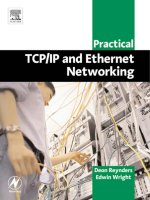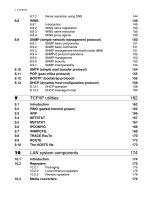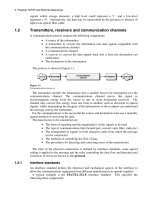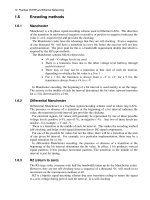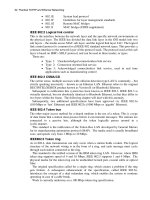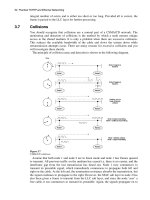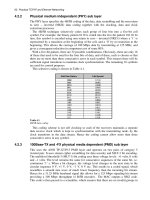Practical TCP/IP and Ethernet Networking- P7 ppt
Bạn đang xem bản rút gọn của tài liệu. Xem và tải ngay bản đầy đủ của tài liệu tại đây (186.47 KB, 5 trang )
6XGIZOIGR:)6/6GTJ+ZNKXTKZ4KZ]UXQOTM
+TIUJOTMSKZNUJY
3GTINKYZKX
Manchester is a bi-phase signal-encoding scheme used in Ethernet LANs. The direction
of the transition in mid-interval (negative to positive or positive to negative) indicates the
value (1 or 0, respectively) and provides the clocking.
The Manchester codes have the advantage that they are self-clocking. Even a sequence
of one thousand ‘0s’ will have a transition in every bit; hence the receiver will not lose
synchronization. The price paid for this is a bandwidth requirement double that which is
required by the RZ-type methods.
The Manchester scheme follows these rules:
• +V and –V voltage levels are used
• There is a transition from one to the other voltage level halfway through
each bit interval
• There may or may not be a transition at that start of each bit interval,
depending on whether the bit value is a 0 or 1
• For a 1 bit, the transition is always from a –V to +V; for a 0 bit, the
transition is always from a +V to a –V
In Manchester encoding, the beginning of a bit interval is used merely to set the stage.
The activity in the middle of each bit interval determines the bit value: upward transition
for a 1 bit, downward for a 0 bit.
*OLLKXKTZOGR3GTINKYZKX
Differential Manchester is a bi-phase signal-encoding scheme used in token ring LANs.
The presence or absence of a transition at the beginning of a bit interval indicates the
value; the transition in mid-interval just provides the clocking.
For electrical signals, bit values will generally be represented by one of three possible
voltage levels: positive (+V), zero (0 V), or negative (–V). Any two of these levels are
needed – for example, + V and –V.
There is a transition in the middle of each bit interval. This makes the encoding method
self-clocking, and helps avoid signal distortion due to DC signal components.
For one of the possible bit values but not the other, there will be a transition at the start
of any given bit interval. For example, in a particular implementation, there may be a
signal transition for a 1 bit.
In differential Manchester encoding, the presence or absence of a transition at the
beginning of the bit interval determines the bit value. In effect, 1 bit produces vertical
signal patterns; 0 bits produce horizontal patterns. The transition in the middle of the
interval is just for timing.
8@XKZ[XTZU`KXU
The RZ-type codes consume only half the bandwidth taken up by the Manchester codes.
However, they are not self-clocking since a sequence of a thousand ‘0s’ will result in no
movement on the transmission medium at all.
RZ is a bipolar signal-encoding scheme that uses transition coding to return the signal
to a zero voltage during part of each bit interval. It is self-clocking.
/TZXUJ[IZOUTZUIUSS[TOIGZOUTY
In the differential version, the defining voltage (the voltage associated with the first half
of the bit interval) changes for each 1 bit, and remains unchanged for each 0 bit.
In the non-differential version, the defining voltage changes only when the bit value
changes, so that the same defining voltages are always associated with 0 and 1. For
example, +5 volts may define a 1, and –5 volts may define a 0.
48@TUTXKZ[XTZU`KXU
NRZ is a bipolar encoding scheme. In the non-differential version it associates, for
example, +5 V with 1 and –5 V with 0.
In the differential version, it changes voltages between bit intervals for 1 values but not
for 0 values. This means that the encoding changes during a transmission. For example, 0
may be a positive voltage during one part, and a negative voltage during another part,
depending on the last occurrence of a 1. The presence or absence of a transition indicates
a bit value, not the voltage level.
32:
MLT-3 is a three-level encoding scheme that can also scramble data. This scheme is one
proposed for use in FDDI networks. The MLT-3 signal-encoding scheme uses three
voltage levels (including a zero level) and changes levels only when a 1 occurs.
It follows these rules:
• +V, 0 V, and –V voltage levels are used
• The voltage remains the same during an entire bit interval; that is, there are
no transitions in the middle of a bit interval
• The voltage level changes in succession; from +V to 0 V to –V to 0 V to +V,
and so on
• The voltage level changes only for a 1 bit
MLT-3 is not self-clocking, so that a synchronization sequence is needed to make sure
the sender and receiver are using the same timing.
((
The Manchester codes, as used for 10 Mbps Ethernet, are self-clocking but consume
unnecessary bandwidth. For this reason, it is not possible to use it for 100 Mbps Ethernet
over CAT5 cable. A solution to the problem is to revert back to one of the more
bandwidth efficient methods such as NRZ or RZ. The problem with these, however, is
that they are not self-clocking and hence the receiver loses synchronization if several
zeros are transmitted sequentially. This problem, in turn, is overcome by using the 4B/5B
technique.
The 4B/5B technique codes each group of four bits into a five-bit code. For example,
the binary pattern 0110 is coded into the five-bit pattern 01110. This code table has been
designed in such a way that no combination of data can ever be encoded with more than 3
zeros on a row. This allows the carriage of 100 Mbps data by transmitting at 125 MHz, as
opposed to the 200 Mbps required by Manchester encoding.
6XGIZOIGR:)6/6GTJ+ZNKXTKZ4KZ]UXQOTM
Table 1.1
4B/5B data coding
+XXUXJKZKIZOUT
All practical data communications channels are subject to noise, particularly where
equipment is situated in industrial environments with high electrical noise, such as
electromagnetic radiation from adjacent equipment or electromagnetic induction from
adjacent cables. As a consequence the received data may contain errors. To ensure
reliable data communication we need to check the accuracy of each message.
Asynchronous systems often use a single bit checksum, the parity bit, for each message,
calculated from the seven or eight data bits in the message. Longer messages require
more complex checksum calculations to be effective. For example the
longitudinal
redundancy check
(LRC) calculates an additional byte covering the content of the
message (up to 15 bytes) while an arithmetic checksum (calculates two additional bytes)
can be used for messages up to 50 bytes in length. Most high-speed local area networks
uses a 32-bit
cyclic redundancy check
(CRC).
)_IROIXKJ[TJGTI_INKIQ)8)
The cyclic redundancy check (CRC) enables detection of errors with very high accuracy
in messages of any length. So, for example, we can detect the presence of a single bit in
error in a synchronous data frame containing 36 000 bits. The CRC works by treating all
the bits of the message block as one binary number that is then divided by a known
polynomial. For a 32-bit CRC this is a specific 32-bit generator, specially chosen to
detect very high percentages of errors, including all error sequences of less than 32 bits.
The remainder found after this division process is the CRC. Calculation of the CRC is
carried out by the hardware in the transmission interface of LAN adapter cards.
2
4KZ]UXQOTML[TJGSKTZGRY
5HPKIZO\KY
When you have completed study of this chapter you should be able to:
• Explain the difference between circuit switching and packet switching
• Explain the difference between connectionless and connection oriented
communication
• Explain the difference between a datagram service and a virtual circuit
• List the differences between local area networks, metropolitan area
networks, wide area networks and virtual private networks
• Describe the concept of layered communications model
• Describe the functions of each layer in the OSI reference model
• Indicate the structure and relevance of the IEEE 802 (ISO 8802) series of
Standards and Working Groups
• Identify hub, ring and bus topologies – from a physical as well as from a
logical point of view
• Describe the basic mechanisms involved in contention, token passing and
polling media access control methods
5\KX\OK]
Linking computers and other devices together to share information is nothing new. The
technology for local area networks (LANs) was developed in the 1970s by
minicomputer manufacturers to link widely separated user terminals to computers. This
allowed the sharing of expensive peripheral equipment as well as data that may have
previously existed in only one physical location.
A LAN is a communications path between one or more computers, file-servers,
terminals, workstations and various other intelligent peripheral equipment, which are
generally referred to as devices or hosts. A LAN allows access to devices to be shared by
several users, with full connectivity between all stations on the network. It is usually
6XGIZOIGR:)6/6GTJ+ZNKXTKZ4KZ]UXQOTM
owned and administered by a private owner and is located within a localized group of
buildings.
The connection of a device into a LAN is made through a node. A node is any point
where a device is connected and each node is allocated a unique address number. Every
message sent on the LAN must be prefixed with the unique address of the destination.
All devices connected to nodes also watch for any messages sent to their own addresses
on the network. LANs operate at relatively high speeds (Mbps range and upwards) with a
shared transmission medium over a fairly small geographical (i.e. local) area.
In a LAN, the software controlling the transfer of messages among the devices on the
network must deal with the problems of sharing the common resources of the network
without conflict or corruption of data. Since many users can access the network at the
same time, some rules must be established on which devices can access the network,
when and under what conditions. These rules are covered under the general subject of
media access control.
When a node has access to the channel to transmit data, it sends the data within a packet
(or frame), which includes, in its header, the addresses of both the source and the
destination. This allows each node to either receive or ignore data on the network.
4KZ]UXQIUSS[TOIGZOUT
There are two basic types of communications processes for transferring data across
networks, viz. circuit switching and packet switching. These are illustrated in
Figure 2.1
Figure 2.1
Circuit switched and packet switched data
